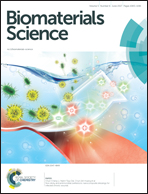Non-sticky and antimicrobial zwitterionic nanocomposite dressings for infected chronic wounds†
Abstract
Zwitterionic poly(sulfobetaine acrylamide) (pSBAA)-based nanocomposite hydrogels impregnated with germicidal silver nanoparticles (AgNPs) were synthesized and implemented for the treatment of infected chronic wounds. The zwitterionic hydrogels exhibited excellent non-sticky properties and had reinforced mechanical properties by the addition of hectorite nanoclay and poly(ethylene glycol)dimethacrylate as physical and chemical crosslinkers, respectively. In addition, AgNPs were grown within the intercalated clay/polymer structure by in situ free radical reduction, as confirmed by UV-vis spectroscopy and transmission electron microscopy (TEM). The silver-containing pSBAA nanocomposite hydrogels (pSBAA/Ag) exhibited germicidal properties against Gram-positive S. epidermidis and Gram-negative P. aeruginosa. The zwitterionic hydrogels show higher water content than 2-hydroxyethyl methacrylate (pHEMA) hydrogels, owing to the strong hydration via ionic solvation. The negligible cytotoxicity of pSBAA/Ag hydrogels was assessed with human fibroblasts by the MTT assay. Moreover, the zwitterionic hydrogels demonstrated excellent resistance to the adsorption of bovine serum albumin (BSA). To evaluate the feasibility of the hydrogels for clinical application as wound dressings, we created infected diabetic rat models and compared with commercial wound dressings. The results show that pSBAA/Ag hydrogels did not adhere to the newly formed tissue, and were readily removed from the wounds after treatment for 3 days. Moreover, the healing recovery was evaluated by visual observation of infected dorsal wounds on rats with induction of diabetes by streptozotocin. The finding indicates complete healing with the pSBAA/Ag hydrogels after 15 days, faster than other dressings. A histological examination also proved that the zwitterionic hydrogels facilitated epithelialization and collagen distribution in the infected diabetic wounds. Consequently, these novel non-sticky and antimicrobial zwitterionic nanocomposite hydrogels can have high potential for the treatment of infected chronic wounds.



 Please wait while we load your content...
Please wait while we load your content...